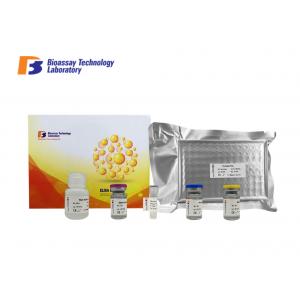Rat High Sensitivity Insulin Like Groeth Factor Binding Protein 3 Sandwich ELISA Kit For Research
Add to Cart

Rat High Sensitivity Insulin Like Groeth Factor Binding Protein 3 ELISA Sandwich Kit For Research
Cat.No E1613Ra
Standard Curve Range: 2ng/ml - 600ng/ml
Sensitivity: 0.93ng/ml
Size: 96 wells
Storage: Store the reagents at 2-8°C. For over 6-month storage refer to the expiration date keep it at -20°C. Avoid repeated thaw cycles. If individual reagents are opened it is recommended that the kit be used within 1 month.
*This product is for research use only, not for use in diagnosis procedures. It’s highly recommend to read this instruction entirely before use.
Precision
Intra-Assay Precision (Precision within an assay) Three samples of known concentration were tested on one plate to assess intra-assay precision.
Inter-Assay Precision (Precision between assays) Three samples of known concentration were tested in separate assays to assess inter-assay precision.
CV(%) = SD/mean x 100
Intra-Assay: CV<8%
Inter-Assay: CV<10%
Intended Use
This sandwich kit is for the accurate quantitative detection of Rat Insulin Like Groeth Factor Binding Protein 3 (also known as IGFBP3) in serum, plasma, cell culture supernates, cell lysates, tissue homogenates.
Assay Principle
This kit is an Enzyme-Linked Immunosorbent Assay (ELISA). The plate has been pre-coated with Rat IGFBP3 antibody. IGFBP3 present in the sample is added and binds to antibodies coated on the wells. And then biotinylated Rat IGFBP3 Antibody is added and binds to IGFBP3 in the sample. Then Streptavidin-HRP is added and binds to the Biotinylated IGFBP3 antibody. After incubation unbound Streptavidin-HRP is washed away during a washing step. Substrate solution is then added and color develops in proportion to the amount of Rat IGFBP3. The reaction is terminated by addition of acidic stop solution and absorbance is measured at 450 nm.
Precautions
- Prior to use, the kit and sample should be warmed naturally to room temperature 30 minutes.
- This instruction must be strictly followed in the experiment.
- Once the desired number of strips has been removed, immediately reseal the bag to protect the remain from deterioration. Cover all reagents when not in use.
- Make sure pipetting order and rate of addition from well-to-well when pipetting reagents.
- Pipette tips and plate sealer in hand should be clean and disposable to avoid cross-contamination.
- Avoid using the reagents from different batches together.
- Substrate solution B is sensitive to light, don’t expose substrate solution B to light for a long time.
- Stop solution contains acid. Please wear eye, hand and skin protection when using this material. Avoid contact of skin or mucous membranes with kit reagent.
- The kit should not be used beyond the expiration date.
Specimen Collection
Serum Allow serum to clot for 10-20 minutes at room temperature. Centrifuge at 2000-3000 RPM for 20 minutes.
Plasma Collect plasma using EDTA or heparin as an anticoagulant. Centrifuge samples for 15 minutes at 2000-3000 RPM at 2 - 8°C within 30 minutes of collection.
Urine Collect by sterile tube. Centrifuge at 2000-3000 RPM for approximately 20 minutes. When collecting pleuroperitoneal fluid and cerebrospinal fluid, please follow the procedures above-mentioned.
Cell Culture Supernatant Collect by sterile tubes when examining secrete components. Centrifuge at 2000-3000 RPM for approximately 20 minutes. Collect the supernatants carefully. When examining the components within the cell, use PBS (pH 7.2-7.4) to dilute cell suspension to the cell concentration of approximately 1 million/ml. Damage cells through repeated freeze-thaw cycles to let out the inside components. Centrifuge at 2000-3000 RPM for approximately 20 minutes.
Tissue Rinse tissues in PBS (pH 7.4) to remove excess blood thoroughly and weigh before homogenization. Mince tissues and homogenize them in PBS (pH7.4) with a glass homogenizer on ice. Thaw at 2-8°C or freeze at -20°C. Centrifuge at 2000-3000 RPM for approximately 20 minutes.
Note
- Sample concentrations should be predicted before being used in the assay. If the sample concentration is not within the range of the standard curve, users must contact us to determine the optimal sample for their particular experiments.
- Samples to be used within 5 days should be stored at 2-8°C. Samples should be aliquoted or must be stored at -20°C within 1 month or -80°C within 6 months. Avoid repeated freeze thaw cycles.
- Samples should be brought to room temperature before starting the assay.
- Centrifuge to collect sample before use.
- Samples containing NaN3 can’t be tested as it inhibits the activity of Horse Radish Peroxidase (HRP).
- Collect the supernatants carefully. When sediments occurred during storage, centrifugation should be performed again.
- Hemolysis can greatly impact the validity of test results. Take care to minimize hemolysis.
*Sample can't be diluted with this kit. Owing to the the material we use to prepare the kit, the sample matrix interference may falsely depress the specificity and accuracy of the assay.
Summary
1. Prepare all reagents, samples and standards.
2. Add sample and ELISA reagent into each well. Incubate for 1 hour at 37°C.
3. Wash the plate 5 times.
4. Add substrate solution A and B. Incubate for 10 minutes at 37°C.
5. Add stop solution and color develops.
6. Read the OD value within 10 minutes.
Calculation of Result
Construct a standard curve by plotting the average OD for each standard on the vertical (Y) axis against the concentration on the horizontal (X) axis and draw a best fit curve through the points on the graph. These calculations can be best performed with computer-based curve-fitting software and the best fit line can be determined by regression analysis.
Referances
"Endotoxin decreases serum IGFBP-3 and liver IGFBP-3 mRNA:
comparison between Lewis and Wistar rats."
Priego T., Ibanez de Caceres I., Martin A.I., Villanua M.A.,
Lopez-Calderon A.
Mol. Cell. Endocrinol. 199:23-28(2003)


